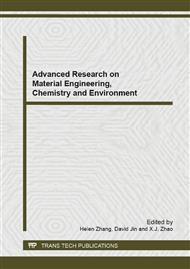p.119
p.127
p.132
p.136
p.141
p.147
p.152
p.159
p.164
Effect of Annealing Treatment on Structure and Electrochemical Properties of LaNi4.5Co0.25Al0.25 Alloy with Low Co Content
Abstract:
The effect of annealing treatment on the structure and electrochemical properties of LaNi4.5Co0.25Al0.25 alloy was studied by X-ray diffraction (XRD), scanning electron microscopy (SEM) and electrochemical measurement. XRD results show that the matrix phases are still LaNi5 (hexagonal CaCu5 type structure) but the intensity peaks become sharper after heat treatment. Electrochemical experiments at 301 K indicate that annealing treatment can significantly improve the discharge capacity and cyclic stability of LaNi4.5Co0.25Al0.25 alloy at suitable treatment condition. The alloy has the best discharge capacity (324.4 mAg-1) due to its composition homogenization after heat treatment at 1373 K/8 h, while the best capacity retention is about 80.12 % because of lower expansion rate and better anti-pulverization ability after heat treatment at 1273 K/8 h.
Info:
Periodical:
Pages:
141-146
Citation:
Online since:
September 2013
Price:
Сopyright:
© 2013 Trans Tech Publications Ltd. All Rights Reserved
Share:
Citation:


